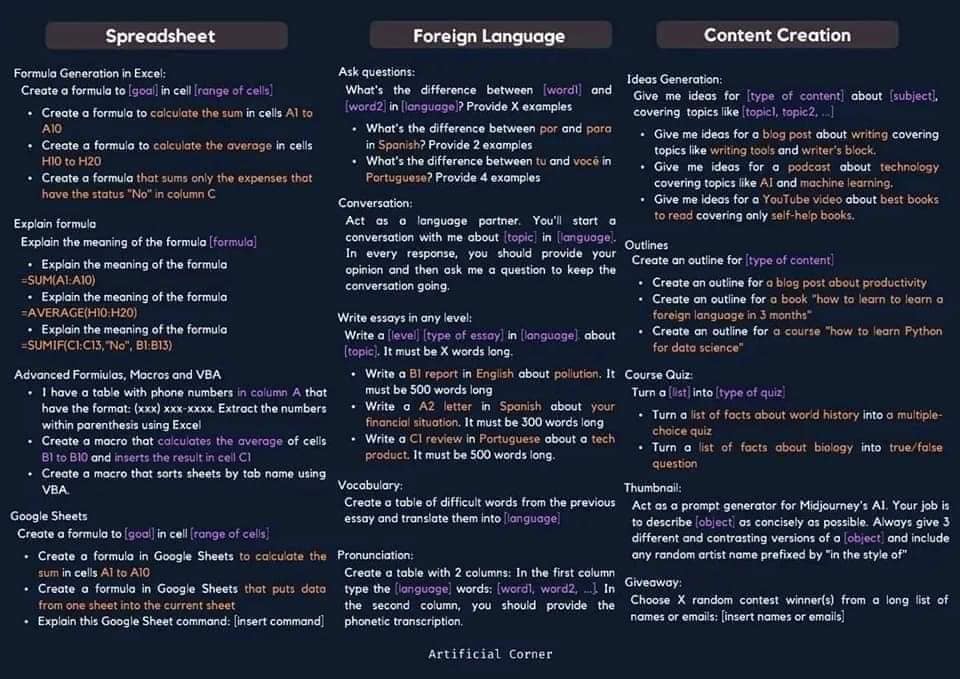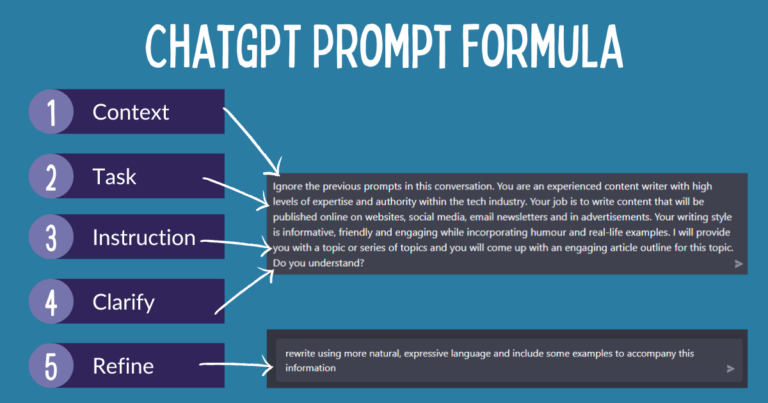“Unlocking Content Creation Superpowers: Mastering ChatGPT Prompts for Powerful Content Pillars
Artikel Terkait Unlocking Content Creation Superpowers: Mastering ChatGPT Prompts for Powerful Content Pillars
- Unlock The Power Of Personalized Outreach: Crafting Cold Email Templates With ChatGPT
- Level Up Your Drip Campaigns With The Power Of ChatGPT: A Guide To Personalized Engagement
- Crafting Compelling Brand Stories With ChatGPT: A Guide To Humanizing Your Business
- ChatGPT For Consultants: A Strategic Advantage Or Just Another Buzzword?
- Unleashing The Power Of AI: Automating Writing Tasks With ChatGPT
Table of Content
- 1 Artikel Terkait Unlocking Content Creation Superpowers: Mastering ChatGPT Prompts for Powerful Content Pillars
- 2 Video tentang Unlocking Content Creation Superpowers: Mastering ChatGPT Prompts for Powerful Content Pillars
- 3 Unlocking Content Creation Superpowers: Mastering ChatGPT Prompts for Powerful Content Pillars
Video tentang Unlocking Content Creation Superpowers: Mastering ChatGPT Prompts for Powerful Content Pillars
Unlocking Content Creation Superpowers: Mastering ChatGPT Prompts for Powerful Content Pillars

In today’s digital landscape, consistent and high-quality content is the lifeblood of any successful brand. But churning out engaging content week after week can be a daunting task. This is where ChatGPT, the powerful AI language model, comes in as a game-changer. However, simply asking "Write a blog post" won’t cut it. To truly leverage ChatGPT’s potential, you need to craft effective prompts tailored to your specific content pillars.
This article will delve deep into the art of creating compelling ChatGPT prompts for building robust content pillars. We’ll explore what content pillars are, why they’re crucial, and how to use ChatGPT to generate content that resonates with your audience, drives traffic, and establishes you as an authority in your niche.
What are Content Pillars and Why are They Important?
Think of content pillars as the sturdy foundations of your content strategy. They are broad, overarching themes or topics that represent the core values, expertise, and offerings of your brand. These pillars act as the central hubs from which you can spin off numerous subtopics and pieces of content.
Here’s why content pillars are essential:
- Organization and Focus: They provide a clear structure for your content, ensuring consistency and preventing you from straying off-topic.
- Audience Relevance: They allow you to focus on topics that are genuinely important to your target audience, attracting and engaging the right people.
- SEO Benefits: By consistently covering related topics under a single pillar, you signal to search engines that you’re an authority on that subject, improving your search rankings.
- Content Repurposing: A single content pillar can be broken down into numerous smaller pieces of content, such as blog posts, social media updates, videos, and infographics, maximizing your content’s reach.
- Brand Building: Consistently addressing key topics strengthens your brand identity and reinforces your expertise in the eyes of your audience.
Crafting Effective ChatGPT Prompts for Content Pillars: A Step-by-Step Guide
The key to unlocking ChatGPT’s potential lies in crafting precise and detailed prompts. The more context you provide, the better the output will be. Here’s a breakdown of the steps involved:
1. Define Your Content Pillars:

Before you even touch ChatGPT, you need to identify your core content pillars. Consider these questions:
- What are the key areas of expertise for your business?
- What problems do your products or services solve for your customers?
- What topics is your target audience most interested in?
- What are your brand values and how can you reflect them in your content?

For example, a fitness company might have content pillars like:
- Nutrition for Performance
- Strength Training for Beginners
- Recovery and Injury Prevention
- Mindfulness and Mental Wellness
2. Research Relevant Keywords:
Once you’ve defined your pillars, research relevant keywords associated with each one. Tools like Google Keyword Planner, SEMrush, and Ahrefs can help you identify high-volume, low-competition keywords that your audience is actively searching for. Incorporate these keywords into your prompts to improve the SEO potential of your content.
3. Structure Your Prompts with Clarity and Detail:
A well-structured prompt should include the following elements:
- The Goal: Clearly state what you want ChatGPT to create (e.g., a blog post, a social media caption, an outline).
- The Topic: Specify the exact subject you want ChatGPT to address, linking it back to your content pillar.
- The Audience: Define your target audience (e.g., beginners, experienced professionals, specific demographics).
- The Tone: Indicate the desired tone of voice (e.g., professional, friendly, humorous, informative).
- The Format: Specify the desired format (e.g., listicle, tutorial, case study, interview).
- The Length: Provide an approximate word count or character limit.
- Specific Instructions: Include any specific instructions, such as key points to cover, examples to include, or sources to cite.
Example Prompts for the "Nutrition for Performance" Content Pillar:
Prompt 1: Blog Post – Beginner’s Guide to Pre-Workout Nutrition
- Goal: Write a blog post.
- Topic: Pre-workout nutrition for beginners.
- Audience: Individuals new to fitness and looking to optimize their pre-workout fuel.
- Tone: Informative and encouraging.
- Format: Blog post with headings, subheadings, and bullet points.
- Length: Approximately 800 words.
- Specific Instructions: Cover the importance of carbohydrates and protein, provide examples of easy-to-prepare pre-workout snacks, and explain the timing of pre-workout meals. Include a call to action to download a free pre-workout recipe guide. Use the keyword "pre-workout nutrition."
Prompt 2: Social Media Caption – Debunking Common Nutrition Myths for Athletes
- Goal: Write a social media caption for Instagram.
- Topic: Debunking common nutrition myths for athletes.
- Audience: Athletes and fitness enthusiasts.
- Tone: Informative and engaging.
- Format: Short caption with bullet points and relevant hashtags.
- Length: Under 200 characters.
- Specific Instructions: Debunk myths like "carbs are bad" and "you need tons of protein to build muscle." Include hashtags like #nutrition, #athlete, #fitness, #myths.
Prompt 3: Outline – The Ultimate Guide to Post-Workout Recovery Nutrition
- Goal: Create an outline for a comprehensive guide.
- Topic: Post-workout recovery nutrition.
- Audience: Athletes and fitness enthusiasts looking to optimize their recovery.
- Tone: Informative and comprehensive.
- Format: Detailed outline with main sections and sub-sections.
- Length: As detailed as possible.
- Specific Instructions: Include sections on the importance of protein, carbohydrates, and hydration for recovery. Suggest specific food and supplement options. Include a section on timing and meal planning.
4. Iterate and Refine:
The first output from ChatGPT may not be perfect. Don’t be afraid to iterate and refine your prompts based on the results. Try rephrasing your instructions, adding more detail, or adjusting the tone of voice. You can also provide feedback to ChatGPT and ask it to revise the content based on your specific requirements.
5. Humanize and Personalize:
While ChatGPT can generate impressive content, it’s crucial to add your own unique voice and perspective. Review the generated content carefully and make sure it aligns with your brand’s values and personality. Add personal anecdotes, real-life examples, and unique insights to make the content more engaging and relatable.
Advanced Prompting Techniques for Deeper Content Creation
Beyond the basic structure, here are some advanced prompting techniques to unlock even more potential from ChatGPT:
- Role-Playing: Ask ChatGPT to assume the role of an expert in a particular field (e.g., "Act as a registered dietitian and explain the benefits of creatine supplementation").
- Storytelling: Frame your prompts around a story or scenario to make the content more engaging (e.g., "Imagine a client struggling to gain muscle. How would you advise them on their nutrition plan?").
- Comparative Analysis: Ask ChatGPT to compare and contrast different approaches or strategies (e.g., "Compare the benefits and drawbacks of intermittent fasting versus traditional meal timing for weight loss").
- Data-Driven Content: Provide ChatGPT with relevant data or statistics to incorporate into the content (e.g., "Based on the latest research on protein intake, what is the optimal amount of protein for muscle growth?").
- Prompt Chaining: Use the output from one prompt as the input for another (e.g., "First, generate a list of common workout mistakes. Then, ask ChatGPT to write a blog post on how to avoid these mistakes").
Examples of Content Pillars and Corresponding ChatGPT Prompts
Here are a few more examples of content pillars and sample ChatGPT prompts:
Content Pillar: Sustainable Living
- Prompt: Blog Post – 10 Easy Ways to Reduce Your Carbon Footprint at Home (Target audience: Beginners, Tone: Informative and practical, Length: 700 words)
- Prompt: Social Media Caption – Share a tip for reducing plastic waste. (Target audience: General public, Tone: Encouraging and positive, Length: Under 150 characters, include hashtags #sustainableliving #plasticfree)
- Prompt: Outline – The Ultimate Guide to Composting for Beginners (Target audience: Beginners, Tone: Comprehensive and detailed, Length: Detailed outline with sections on composting methods, materials, and troubleshooting)
Content Pillar: Financial Literacy
- Prompt: Blog Post – Investing for Beginners: A Step-by-Step Guide (Target audience: Beginners, Tone: Informative and accessible, Length: 900 words)
- Prompt: Social Media Caption – What is the difference between stocks and bonds? (Target audience: General public, Tone: Simple and clear, Length: Under 200 characters, include hashtags #investing #finance)
- Prompt: Generate a list of 5 common money management mistakes and how to avoid them. (Target audience: General public, Tone: Informative and helpful, Length: Concise list with explanations)
FAQ – Frequently Asked Questions about ChatGPT Prompts for Content Pillars
Q: Can I use ChatGPT to generate all my content?
A: While ChatGPT is a powerful tool, it’s best used as a starting point or a supplement to your existing content creation process. Always review and edit the generated content to ensure accuracy, originality, and alignment with your brand voice.
Q: How do I avoid plagiarism when using ChatGPT?
A: Always run the generated content through a plagiarism checker to identify any potential issues. Rewrite and rephrase any sections that are flagged as plagiarized.
Q: What if ChatGPT’s output is not what I expected?
A: Refine your prompt by adding more detail, clarifying your instructions, or adjusting the tone of voice. Experiment with different prompting techniques to see what works best.
Q: How can I ensure the accuracy of the information generated by ChatGPT?
A: Always fact-check the information provided by ChatGPT against reliable sources. Do not rely solely on ChatGPT for factual accuracy.
Q: What are the limitations of ChatGPT for content creation?
A: ChatGPT may struggle with complex or nuanced topics. It can also sometimes generate inaccurate or biased information. It’s essential to use your own judgment and expertise to evaluate the quality of the generated content.
Conclusion: Embracing AI for Content Creation Success
ChatGPT is a valuable tool for content creators, but it’s not a magic bullet. By mastering the art of crafting effective prompts, you can unlock its potential to generate high-quality content that supports your content pillars, engages your audience, and drives results. Remember to focus on clarity, detail, and iteration, and always humanize and personalize the generated content to reflect your brand’s unique voice and perspective. Embrace AI as a powerful ally in your content creation journey, and watch your content strategy soar.

